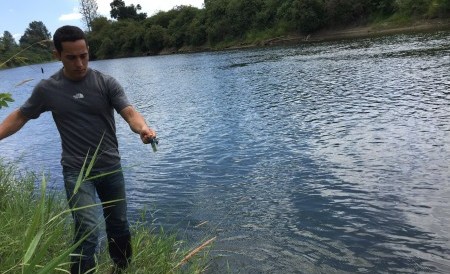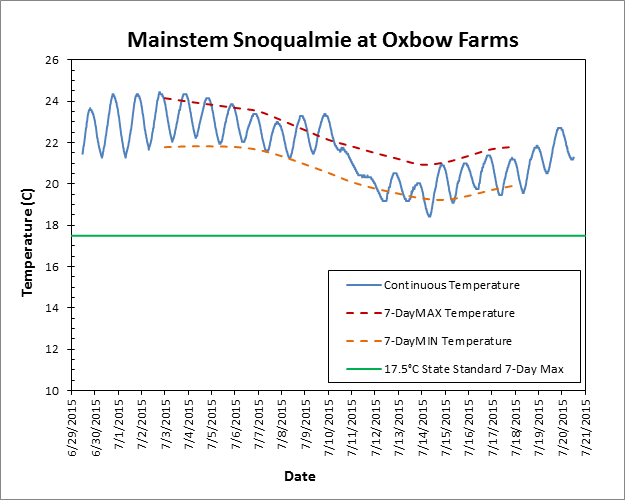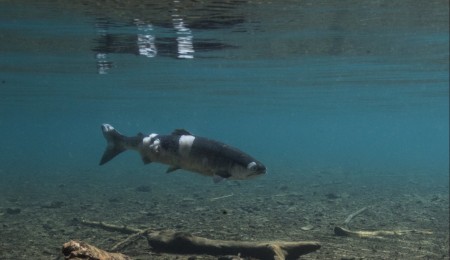Our salmon are in hot water
Plenty of credit has been given in the media to the farmers who are (like always) trying to make ends meet. This year’s conditions have been especially challenging–unfamiliar at best and downright punishing at worst. Those of us in the Snoqualmie Valley are relatively lucky to have a somewhat dependable source of water and temperatures at least in the same ballpark as reasonable. The situation elsewhere is more serious. Earlier this season, temperatures around Washington have fried raspberries, cracked roads, and recently driven the state to suspend irrigation rights for hundreds of farmers as rivers drop to less than a quarter of their normal flows.
Where farmers are struggling to grow food and remain viable in the face of such unusual conditions, animals, particularly salmon, are struggling to stay alive. The Seattle Times reported last week on the unfortunate fate of sockeye salmon in the Columbia River, where fish have already been dying, victims of water temperatures roughly five degrees warmer than average for this time of year.
A Columbia River sockeye salmon with large patches of white fungus. Warm water puts salmon at greater risk of disease. Photo via Seattle Times
Our own Snoqualmie River is under similarly warm conditions and our salmon are in for a difficult, if not impossible, spawning season. The fish can’t handle long periods of warm water, and the river is not only warmer-than-average from the duress of high air temperatures, but is continuing to warm at faster rates than normal because flows are so low. For experts, scarier than this season’s drought and its many implications is the worry that a changing climate may mean that years like this one, or worse, will become far more common.
With this possibility in mind, the Snoqualmie Watershed Forum and King County’s Water & Land Resources Division recently launched a project to better understand factors that influence water temperatures in our river and to get a clearer picture of what a very extreme year looks like. Janne Kaje, King County’s Snoqualmie Watershed Coordinator, and his team have deployed 27 different thermistor instruments to continuously monitor water temperature to sites along the Snoqualmie and its tributaries throughout the county. One of these thermistors is on Oxbow’s stretch of the river between Carnation and Duvall. We have been fortunate to learn more from Janne about what’s driving the project and what the implications of its findings will be.

King County water quality planner Josh Kubo retrieves a thermistor from the Snoqualmie River at Oxbow in July
Janne’s team is approaching the project with a few important facts already established:
Fact #1: The Snoqualmie is considerably warmer than usual already this season, and it’s going to get warmer
It will likely be no surprise to any King County resident that our rivers are warmer than usual. To start with, it has been HOT. Besides the obvious cause of warmer summer temperatures heating the water, rivers are more susceptible to heating up because there is less water in them to begin with. As skiers will remember, there was hardly any snow this past winter, and therefore very little spring and summer snowmelt to boost the Snoqualmie’s Cascade Mountain headwaters. Rain, which both cools the river and adds to its volume–has been all but nonexistent since April.
At this point, flows are about a quarter to a third of what’s normal for this time of year, and temperature measurements in some locations are reading in at six or more degrees Celsius higher than average. And the rest-of-season prognosis is grim. High air temperatures will evaporate a higher percentage of the river’s water and farmers must respond to the dry conditions with more irrigation. The less water in the rivers, the faster they will heat up. Interesting, too, is the effect of channel width: The less water that a river contains, the shallower and thinner its wetted channel. At extreme low flows, rivers tend to be concentrated in the middle of their beds, and are less protected by the shade of trees on the riverbank. More sunlight, more evaporation, less water, higher temperatures. The hamster wheel spins itself.
Fact #2: The water is way too warm for salmon
The State of Washington identifies 17.5° C as the temperature above which salmon will start to struggle. To be more specific, a river in which the seven day running maximum, the average maximum temperature of seven consecutive days exceeds 17.5° is harmful for juvenile salmon and migrating adults. Spawning salmon need even cooler water. Recent daily maximums in the Snoqualmie adjacent to Oxbow have been exceeding 24° C. This is the salmon equivalent of spending all day in a sauna.
Fish are cold-blooded so, unlike humans, they cannot regulate their own body temperatures. When temperatures rise above a point of comfort, simply staying alive becomes stressful. Warm water has less dissolved oxygen, so breathing is a challenge. Moreover, warmer water supports more bacteria and viruses while at the same time adding stress to salmon immune systems. With the added stress of an increased metabolic rate, the fish burn through their energy stores more quickly, leaving those that can survive a warm spell utterly drained of energy to make their way upstream to spawn.
With these two givens in mind, Janne and his team are hoping to better understand how temperature maximums and daily fluctuations vary along the length of the river. Temperature measures indicate that that water warms steadily and predictably as it flows downstream under a hot sun.. But rivers can be suddenly cooled where they are fed by groundwater seeps releasing cold water into the river below the surface. Depending on the severity of situation, these pockets of cool water can provide a life-saving refuge for stressed salmon populations. Locating and understanding these cool spots is of major interest to Janne and his team.
By taking multiple measures in different parts of the river, the researchers also hope to link temperature fluctuations to visible differences in riverbank landscapes. Presuming that more hot, dry years are in store, the county is learning what effect riverbank restoration can have on shade, water temperatures and, in turn, salmon survival.
Janne’s team collected the first round of temperature readings at Oxbow two weeks ago. Here’s what it looks like:

That squiggly blue line represents the temperature of the water. It is squiggly because the water heats up every day and cools off every night. The straight green line is at 17.5°, the maximum temperature at which the state says salmon can live comfortably. As you can see, even the lowest temperature recorded at Oxbow in these three weeks exceeded that maximum.
Combined with findings from other sites along the river, these data from Oxbow will allow the researchers to Identify areas of the river under extreme stress or that potentially offer salmon a temperature refuge. The season’s data will influence future conservation and restoration efforts.
Janne is the manager of the Snoqualmie Watershed Forum, a coalition of city, county and tribal governments, concerned citizens and non-profit organizations working to improve environmental quality in the Snoqualmie Watershed. The forum was born in 1998 out of an effort to develop a recovery plan for the Snoqualmie’s native population of Chinook salmon. Chinook salmon listed as threatened under the Endangered Species Act. Salmon conservation remains a big part of the Forum’s work to this day.
We will continue to share more information about the project as we hear from the researchers about what’s happening and why. Stay tuned into what’s happening here.
This article appeared in our newsletter August 3. Sign up to receive it.
Want more Ox? Follow us on Facebook, Twitter, or Instagram or subscribe to our newsletter.

